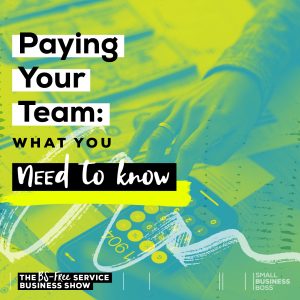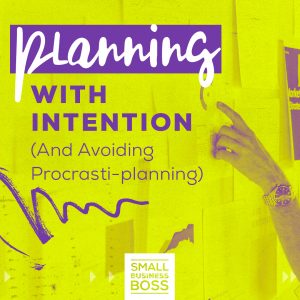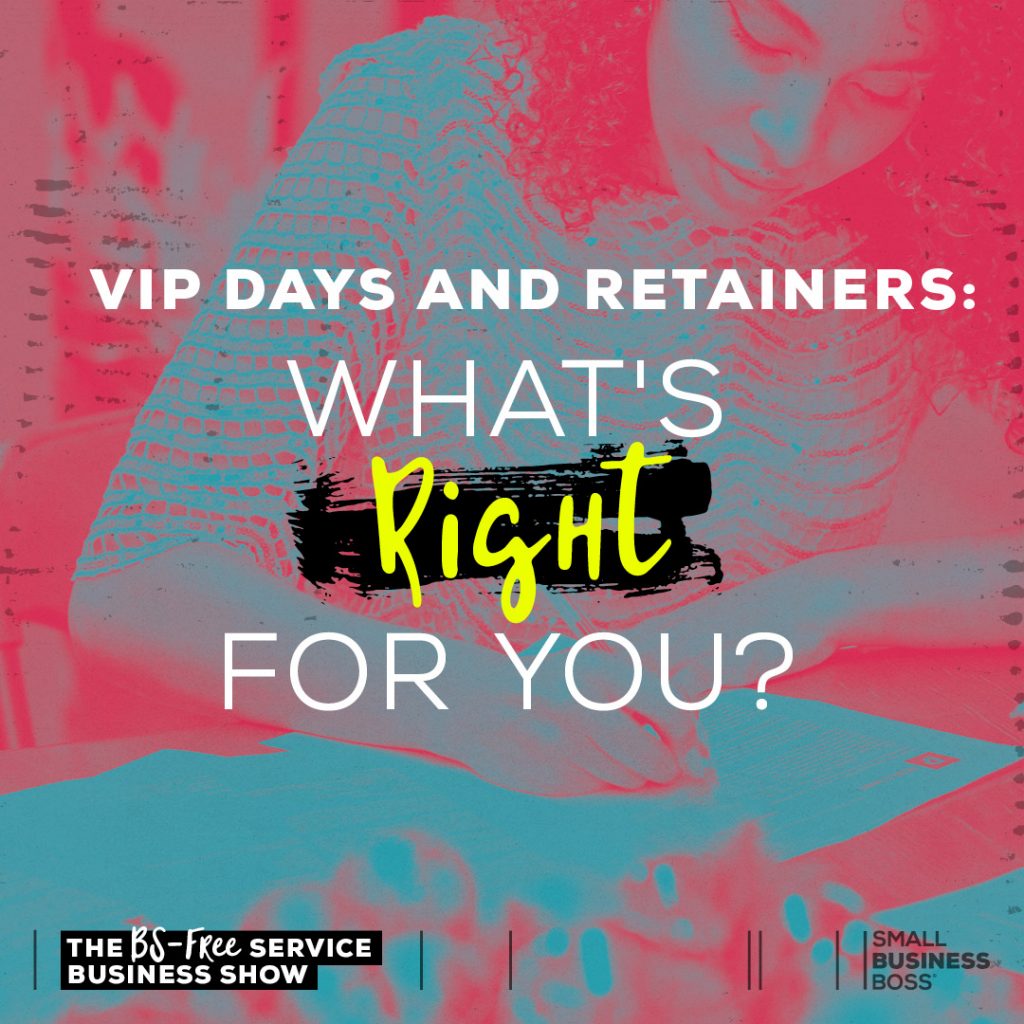
Search the site:
VIP Days and Retainers: What’s Right For You?
When you run a service business, you’ve got countless options for how you package and deliver your services. This can be overwhelming, especially when hot new trends are popping up that can make you feel like you’re missing something.
In this episode, we’re digging into two popular delivery models and asking the question, what’s right for you?
You know last week when we were talking about awkward client moments? That’s partially what inspired this episode, as nothing creates an awkward client moment faster than having a delivery model for our service that’s confusing and doesn’t work for us or our clients.
What’s a Delivery Model?
Before we dive in, I want to briefly touch on what I mean by a delivery model. This refers to the way we deliver our services. For done-for-you service providers like creatives and consultants, there are a lot of potential ways to deliver your work.
As a service business owner, you’ll have your business model which is a service business, and then a delivery model which is the “how” of working with clients. Over the years, I think I’ve tried every single delivery model possible and I’ve seen them in action in my clients’ businesses, and there’s no single solution that works for everyone.
This is why I want to talk about two delivery models in today’s episode, retainers and VIP days. Retainers have been around since the beginning of time, while VIP days or intensives are a trendier option right now.
It’s worth pointing out that the intensive or day-rate model isn’t new. It’s just hyped up in online business and is definitely having a moment. In fact, I was doing day rates for clients back in 2006, so as the saying goes what’s old is new again.
But that hype factor around this model has led to a lot of questions from my clients and community about what delivery model they should be using. There’s a feeling that they may be missing out on an opportunity or that they’re failing if they’re not jumping from project work or retainers into the intensive model.
When you think about different delivery models, an easy way to think about it is in terms of the time commitment. A VIP day is a short-term, one-day engagement, while a project for weeks or months, and a retainer may last for years.
Again, there’s no right or wrong in this, I want to give you the options to consider, and then let you decide what’s the best fit for your business. I’m not one that’s here to hype up any single option, especially as I do retainer, project, and intensives in my business.
For the purposes of this episode, we’re going to look at retainers and VIP days as those are the two delivery models I get the most questions about. My theory is for the most part project work is relatively contained and feels more concrete for most of us.
Plus, when you compare and contrast VIP days and retainers with projects, it’s easy to see how wildly different they really are.
Key Considerations for VIP Days
Let’s start off by talking about VIP days, which may also be called intensives or day rates. The name doesn’t really matter as they’re all the same thing, and the idea is that someone is paying a flat rate for a set amount of your time.
For example, if you’re a designer, you have a client pay a day rate for you to design a set of graphics. If you’re a systems person, you set up a system.
This delivery model can be used for pretty much any type of service by coaches, consultants, and creatives. It offers a way to deliver to a client quickly, and typically it’s priced in a way that reflects the speed involved.
The speed is one of the primary benefits, as well as drawbacks of this model. As a client, it can be appealing to get work done quickly, but you may be sacrificing quality in the process, especially for done-for-you work. And as a service provider, the need to deliver quickly may create a pressure-filled situation and unrealistic expectations, especially as often the client is paying a premium.
One thing I’ve heard a lot from my clients who offer services (especially creatives) is that as appealing as this model is to them, it’s not aligned with how they do their best work. However, for my clients who do more strategic consulting or coaching, it’s easier for them to deliver in this model as there’s not as much focus on a specific output, but more on the time together and the follow-on recommendations.
This brings up something we should all consider with choosing how we deliver which is if this will work for you and if this is in service of the client. Will they get the best result by delivering it in a compressed time frame?
The Promise of VIP Days: Make More, Work Less
A big promise of the intensive model is that you’ll make more money in your business while working less, which truthfully, I find questionable. The reality is that not every client wants to work with service providers in this manner and not every service should be delivered on a tight timeline.
Truth? Where this breaks down for me is that it’s creating a situation that requires you to constantly find new clients and spend more time on marketing. If you need to book four VIP days a month, that’s at least two to three new clients you need to have coming in the door each month. That’s likely going to add a significant level of marketing activity that you may not be expecting.
So while you’re doing client delivery four days a month, you’re likely marketing much, much harder, and there’s a lot more back and forth to get those clients booked when compared with other models. If you don’t enjoy marketing and aren’t awesome at bringing in new clients, you’re likely going to struggle to fill your spots each month.
There are two additional financial considerations that often are missing from this conversation. First, the fact that a business that relies fully on the VIP Day model is likely going to have bigger ups and downs in terms of monthly revenue. You need to be risk-tolerant and understand that month to month you may have more fluctuations in your income.
Also, when pricing your intensive, you need to consider the “hidden” costs of delivering a service. It’s really easy to decide that your hourly rate is $200/hour and say your day rate is for six hours and arrive at $1200 as your price. That doesn’t take into account the prep-work and everything that goes into a successful day rate.
Truth? It’s never just a day so you need to price your VIP day accordingly. As part of that, you need to consider if that final price is realistic for your market, and how exactly you’re going to find those clients.
None of that is to say that the VIP day or intensive model doesn’t work, but rather, you really need to take the time to understand if it will work for the type of service you deliver if there’s a market need for it, and if it will be in service of your clients.
The Need to Know About Retainers
Retainers are a very common delivery model for service providers, and they’re a great way to have ongoing, consistent relationships with clients.
There are two common retainer structures, the first is someone pays you a set amount to “retain” your services, and services are billed against that. That’s commonly used by lawyers and consultants. Another approach is a specific commitment (usually month by month) to a specific number of hours or set of deliverables.
Retainers often get a bad rap as they’re stable and not super exciting. And I’m here today to do a little PR work for them as they’re seriously underrated and for those of you that want stable, predictable income and work, they’re the ideal situation.
There are a lot of benefits to retainers, but hands down the biggest ones are that you have ongoing monthly revenue and don’t need to find clients to replace them. This means less time spent on marketing/sales overall, and fewer ups and downs with your revenue.
Then there’s the relationship part of it. This is really my favorite benefit as there’s a hidden cost to getting to know both a client’s business and their personality. Everyone works a little bit differently, and for a lot of us, that can cause stress or anxiety. Navigating new situations and people can be challenging, so an ongoing relationship helps ease that as we know exactly what to expect.
That certainty is amazing if you have the kinds of clients you enjoy working with and things go smoothly. But when you have retainer clients that aren’t awesome, that can take a toll.
As always, you don’t have to tolerate clients that aren’t a good fit. If you feel like it’s just not going to work, that’s okay. I can think of times over the years where I’ve had to let retainer clients go as what they wanted and what I was prepared to deliver were a mismatch.
If you’re facing that type of situation with your retainers, another delivery model can be very appealing, but I’d encourage you to consider if it’s the delivery model or simply that specific person or type of client.
This is a big reason I pivoted away from working with online businesses back to tech and professional services for retainer work with the agency. I didn’t want to work in online businesses reliant on the launch model and the drama that goes with it.
I’m happy to report that we have multiple retainer clients for the agency, and it’s really our bread and butter. We have predictable monthly revenue, and because we’ve got solid client relationships, I’m able to have my team focus on the majority of the delivery.
The Downside of Retainers
Honestly, I’m such a fan of retainers, that I’ve struggled to come up with potential downsides as part of this discussion.
A potential downside is that retainers aren’t great for you if you get bored really easily. If you want novelty, retainer-based work may be a real snoozefest for you as there will likely be a lot of repetition. Personally, I love the repetition of it as there’s a significant upside when it comes to efficiency as I’m not constantly having to figure new things out. (Or at least that’s true when it comes to the subject matter.)
The other place that retainers can be a bit of a minefield is with boundaries. The longer you’re in a retainer relationship with someone sloppier we can get with boundaries. That’s why if you want the stability of retainers, you need to consider your boundaries constantly and ensure you’re not getting into the habit of making exceptions all the time.
Your ability to hold boundaries with retainers will impact multiple factors from your working relationship to how profitable that client is for your business. Issues like scope creep or over-servicing are common, so being a good steward of your boundaries is essential.
Selling Strategy: VIP Days or Retainers?
Before we wrap up, I wanted to touch on the role of strategy with retainers and VIP days as you’re likely wondering where they may fit. The answer is that strategy work fits beautifully with both, but that you need to be very intentional in how it gets included.
For VIP days, you can literally offer a strategy-only intensive where you’re collaborating with the client in real-time to map out the strategy. This works for coaching, consulting, or even done-for-you services.
Keep in mind that if you’re doing strategy work for VIP days, you need to price it accordingly. There’s value in that strategic thinking and expertise you’re bringing to that session.
That’s why my Sell the Strategy Intensive is priced that way. I know that when my client sells one or two of the strategy offers we develop together, they’ve more than paid for that session. Their path to ROI is incredibly clear.
And on the flip side, if you’re only doing tactical execution for a VIP day, maybe don’t price it the same as you would strategy work. I see a lot of intensives with very tactical work (like making Canva graphics) that are priced like strategy and it makes zero sense to me as a potential client.
Now, if you’re selling strategy as part of a retainer, there are two things to keep in mind. One, if you need to do strategy work upfront, is that a project that goes before the retainer? Or does it need to be the first month or two of your work together?
It’s so easy to just bake it into the retainer and not call it out as strategic, necessary work required to get results. Speaking of which, if your retainer work is a mix of both strategic and tactical work, you need to call that out. So many times clients don’t understand why your rates are the way they are, and it’s because you’re not accounting for strategy.
Case in point: I wrote a proposal earlier this week and I called out the fact that the pricing reflected that this engagement would be both strategic consulting and tactical execution. That helps the client see the value of the strategy and not simply get stuck on a higher than expected price tag.
VIP Days or Retainers: The Choice is Yours
When it comes to deciding on a delivery model, I want you to carefully consider what’s right for you, your clients, and the type of service you deliver. It’s easy to get excited about the promise of any delivery model, but not every possibility will be right for you.
Definitely consider how much marketing you want to be doing, how you best work, what’s simplest to deliver your services and most of all, what your clients are willing to pay for. There’s zero point in trying to sell your services using a delivery model that your clients aren’t going to buy into.
Most of all, don’t believe the hype of any delivery model before you decide it’s the solution for your business. Remember, people pushing a single delivery model are usually selling you something to teach you how to use that model and that may not be the best fit for you.
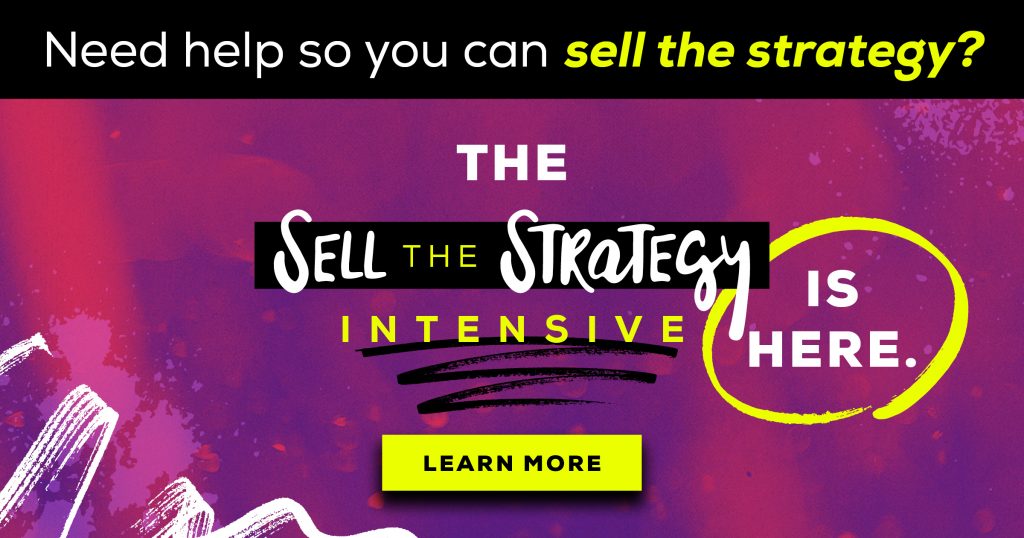

I’m Maggie Patterson (she/her), and services businesses are my business.
I have 20+ years of experience with client services, am a consultant for agency owners, creatives, and consultants, and vocal advocate for humane business practices rooted in empathy, respect, and trust.
Read or Listen to the Latest
For Solo Business Owners
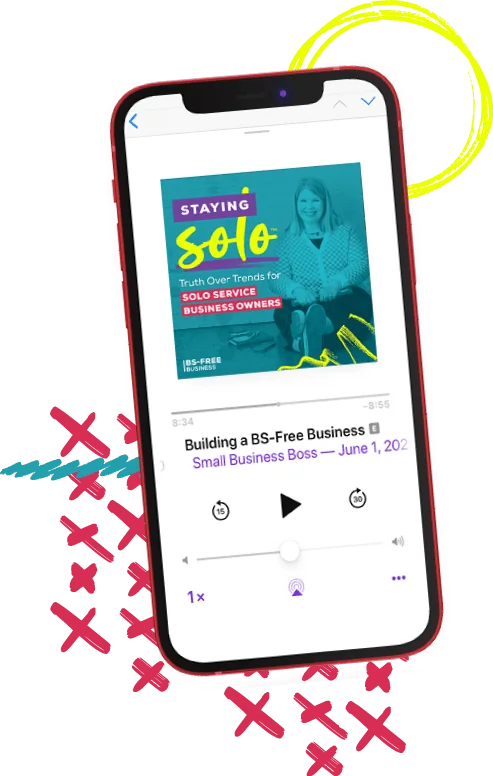
Growing a solo service business is tough.
It’s even harder when you’re bombarded with BS advice that steers you away from your values and why you started your business in the first place.
This is the podcast for solo creatives and consultants who want to remain as a team of one and have zero interest in the hustle and grind of typical business teachings.
Subscribe now and never miss an episode.
For Micro Agency Owners
Most podcasts for agency owners obsess over revenue growth as the ultimate success metric.
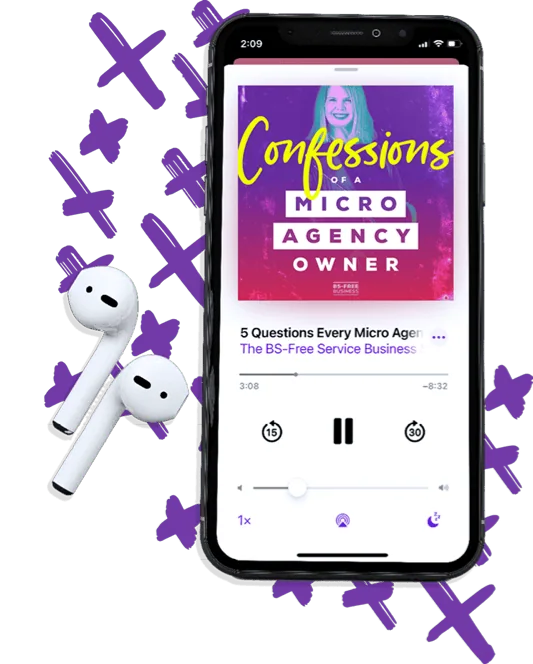
But here’s the truth: not everyone wants to make millions. Your goal might be to build a sustainable business that lets you have a life and doesn’t run you into the ground.
Join me as I spill my shameless confessions and share everything I’ve learned about building a micro agency that skips the BS of tired and typical agency teachings.
Follow Now on All Major Podcast Platforms



